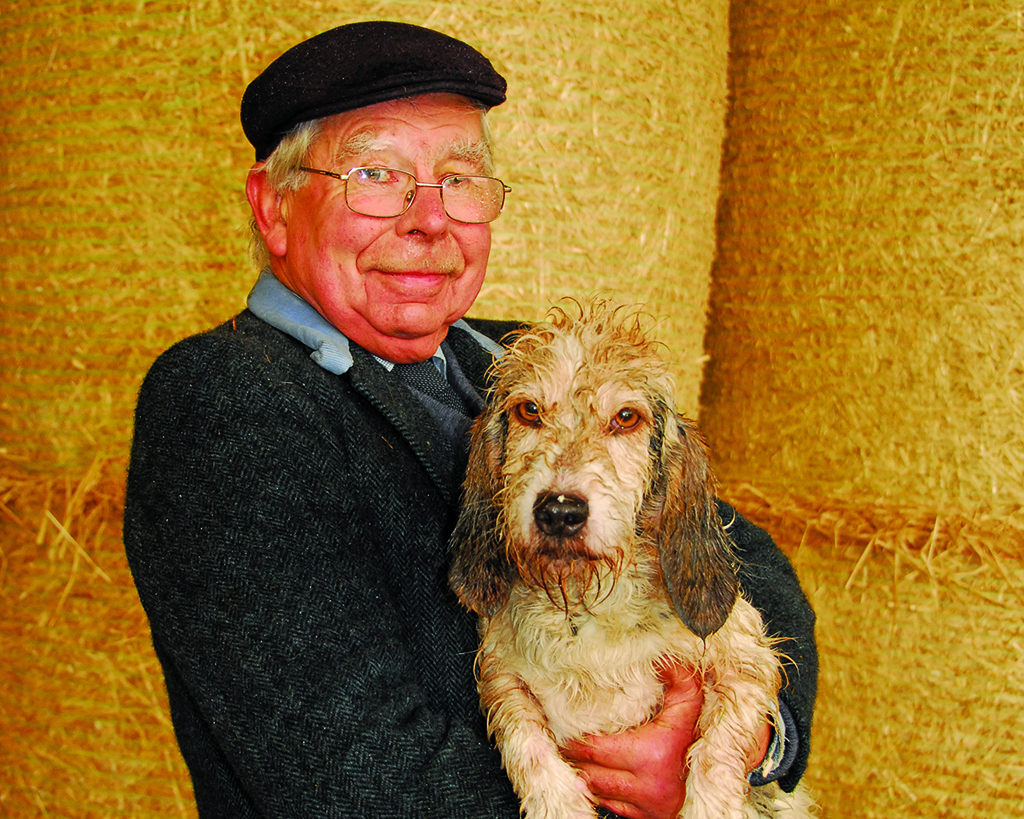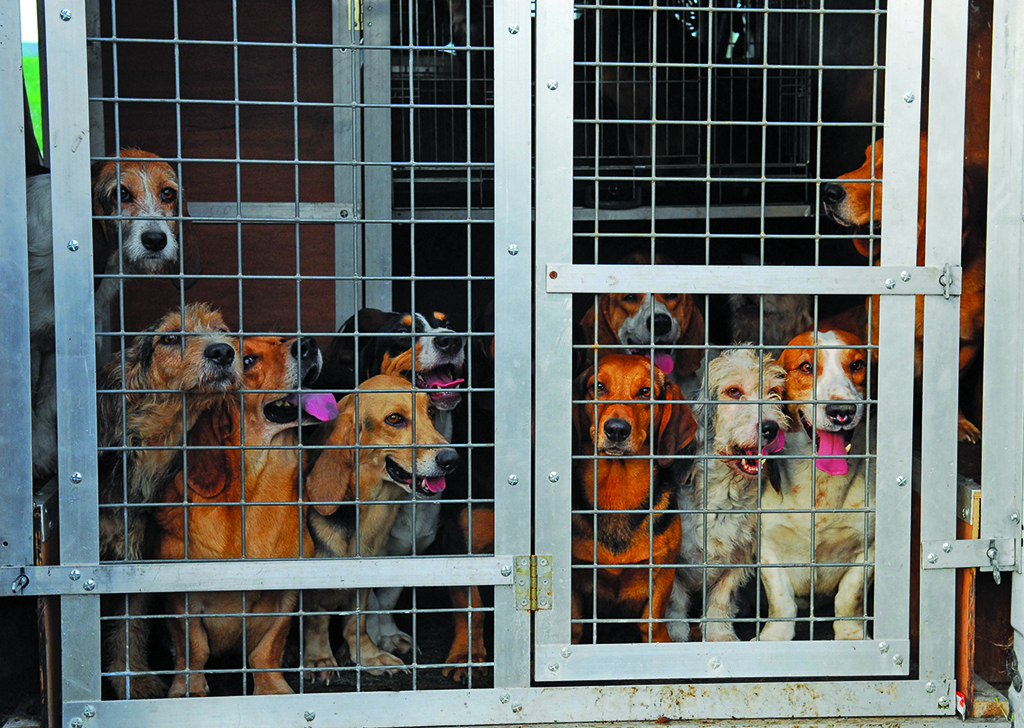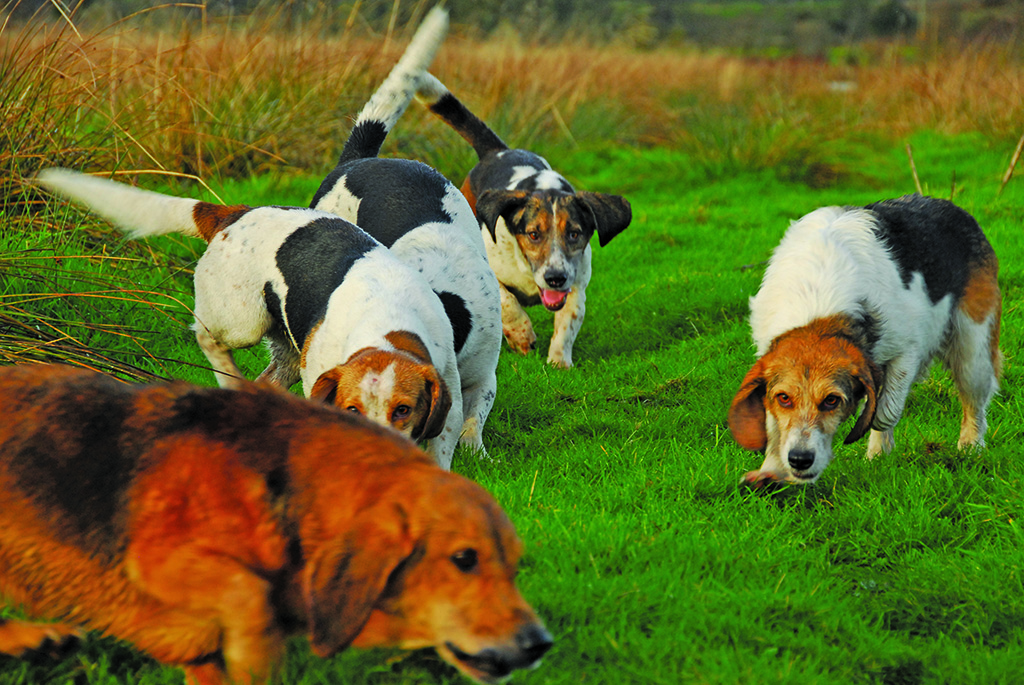
Running with the hounds – meet the Barony Bassets
When the Dumfriesshire Hunt was disbanded in 2002 the area was left without a pack of hounds for the first time in 150 years.
That was until Daphne Thorne put together the Barony Bassets foot pack.
It was a miserable, dreich dawn with a bitter blast of air from the north as we reluctantly started our three-hour drive to Dumfriesshire for our introduction to Scotland’s only basset pack.
The car waltzed her way over the Sma’ Glen’s black ice whilst sleet, hail and snow came at us horizontally shortly before we hit a whiteout as we joined the A9 at Braco. By the time we reached Dumfries, a strange light was adorning the furious sky, battling against curtains of sleet-laden cloud, but now rainbows filled the day with hope. The foot pack’s meet was to be held at Tinwald Parks, and almost as soon as we had arrived at Johnnie Cunningham-Jardine’s picturesque Dumfriesshire home, a white van appeared.
Out of it stepped Daphne Thorne, Master of the Barony Bassets and the woman who, eight years ago and as a direct result of Tony Blair’s hunting ban, decided to strike a blow for freedom and started a pack of her own. ‘You made it, well done!’ she exclaimed, before her husband, chief whipper-in Robert, the van’s other occupant, added: ‘Yes we did rather wonder how on earth we could smile for you today with the weather as it was earlier, but it seems calmer now.’

Robert Thorne with a drookit mutt
She proudly opened the back of the van revealing nine writhing couples of assorted petit Griffon Vendeen bassets. They seemed to smile at us through the mesh, desperate to set to work. Shortly, the farmyard filled with vehicles, their occupants including ferrets and a motley band of excited terriers straining at leashes. The craic was terrific. We exchanged pleasantries whilst piling on more layers and drinking tea (or something stronger), and being introduced to key figures such as dapper First Whip, Callum Rae, who has been with the pack since its formation.
There was little hanging about, just enough time to ensure all were gathered together as the effervescent hounds were released. They flew out in a colourful explosion, and then politely rumbled up to us, brown, ginger, russet, black and tan, long haired, rough haired, smooth haired and somewhere in the middle. I spied some real characters with Rococo legs, and noted that none had the sort of Fred Basset ears that would have inevitably tripped them up. Instead, these had the gait and attitude of working dogs; a far cry from the droopy, shambling bassets of Crufts.
‘It’s all very carefree,’ said Daphne. ‘Many of our hounds originate from the marvellous stock bred by Sir Rupert Buchanan-Jardine at Castlemilk. It seems appropriate that we have managed to keep some of his old lines going. I know at this stage there is great variation but I hope that if I live to be a hundred, I might achieve what I would really like to with their breeding. Bassets are beagles in low-range gear; we chose them because we thought we could keep up with them in our dotage, but actually we can’t.’
Daphne laughed as we set off across a field of winter kale accompanied by a few short blasts of the horn. The weather was now benign, but such was the jolly demeanour of the pack, with their snuffling and incessant waving of sterns, that even had the climate hurled more abuse at us, it could not have marred that wonderful morning.

Smiling hounds are raring to go
Within seconds the hounds were investigating a hedgerow amid unmistakable signs that the place was crawling with rabbits. Pheasants erupted skywards with a clatter, but the dogs, intent on the trail of rabbits, ignored them and pressed on. Their sterns seemed to be moving ever faster, as the whole crew sped off again at breakneck pace with us in hot pursuit. I was regretting the thermal underwear.
Below us a large expanse of snipe bog, bordered by rough fields and woodland, stretched out in front of us. Thick with rushes and laced with little burns and deceptively deep ditches, it was a fine spot. Crossing it back and forth we followed hounds amid a squelching and sucking from boots, and the odd curse or giggle as another person fell in a hole or tripped over a tussock. The landing was as soft as a trampoline and just as bouncy. The earth was indeed moving for us.
A hound spoke, sparking a great orchestration of ‘music’. ‘That’s Gulliver,’ said Daphne as a lovely ginger chap shot past in a spray of mud. ‘He’s always reliable.’
At that moment, a rabbit bolted right over my boots, and like stones fired from catapults the hounds were bounding after it, followed at a slower pace by their human followers. An occasional snipe jinked away. Meanwhile John Steel from Carlisle was busy on a sandy knoll on the skyline with his ferrets and terriers, and Norman Pollen was working a bank elsewhere on the farm. Other hunt supporters waited and watched from a high spot. ‘Since I first came out with Daphne’s bassets, I seldom miss a Sunday, it’s brilliant,’ said Chris Davison, a cheery racehorse haulier from Cumbria.

John Steele with his victorious ferrets
Rabbits were plentiful, although most escaped. The low sun backlit the mire-spattered pack as hounds galloped ecstatically through the undergrowth, ears flapping and jowls quivering. There were several hare-raising moments. In each case the hare careered effortlessly away as Daphne, Robert and Callum called the pack off. The response was impressive, with the hounds quickly switching back to bunnies.
The crossing of a green slime-greased pole over a deep ditch brought hilarity; no one knew if the electric fence beside it was on. ‘Hunting is really in our blood,’ said Daphne, who worked her hounds slickly throughout an afternoon of fantastic sport. ‘For me it’s as much about listening to their music and watching them working. They all have such incredible voices and sometimes when we are in dense woodland the sound echoes all around and is just wonderful. Bassets’ voices are deep, more of a roar than beagles’ – they seem to scream, and we are all about baritones and basses.
‘We tried to breed some hounds with really deep voices and put our two deepest voiced ones together. We ended up with Sebright. Listen, that’s him now. It’s very funny as he just squeaks. I keep wondering when his voice will break. I love that noise too,’ she added as hounds passed close. ‘That is the sound of their flews.’
There was the flapping of jowls and nostrils in the melee. ‘Lieu in! lieu in!’ she called whilst pushing them towards another cover.

The hounds pick up the scent of a rabbit
‘When Sir Rupert Buchanan-Jardine’s famous pack of black and tan foxhounds was disbanded we had no resident pack of our own in Dumfriesshire, which was dismal. For three years we had to rely on kind neighbours bringing their foxhounds to hunt the country and keep it open, until in 2005, with a committee of which I was secretary, the new Dumfriesshire and Stewartry foxhound pack was formed. Robert and I started the bassets in 2006.
Sir Rupert had given up his hare hounds in the 1960s and many of them went to the West Lodge Harehounds, who used to hunt within ten miles of Hyde Park Corner; most of ours are direct descendants. There is a lot of different blood from beagles, harriers, and both English and French bassets’.
A brace of roe deer hiding in the bowels of the bog suddenly took fright, spectacularly leaping away on springs. The hounds were quickly called off, but John Steel’s feisty ginger terrier appeared to be stone deaf and continued defiantly on.
Before long we had reached John, whose ferret had gone to ground, the thrawn beast eventually being located using a detector and then a spade. The sky was darkening, rain laced with venom as the ferret nipped its owner and an Anglo Saxon oath carried on the wind. Meanwhile, Sergeant had appeared cheerily out of the rushes and snaffled the rabbit that had caused the hole-up and was carrying it towards the rest of the pack.

Robert Thorne, Daphne Thorne and dapper First Whip, Callum Rae
‘It looks as though the ferreters have won again as we have only had one kill,’ said Daphne as John tallied his ferrets’ catch to six. Not that the contest was completely over: as we ambled back across the fields towards the farmyard, the hounds put up several rabbits and another hare en route.
Robert, who has been in hunt service for 25 years, worked with several English packs, including the Brecon and Sir Watkin Williams Wynn’s famous hounds. Until they retired, the Thornes ran an animal feed business and are clearly devoted to this impressive self-financed pack.
Whilst she ensured everyone was furnished with tea and thick slabs of her succulent cakes, he was rounding up Sesame and Tidy, who were slinking off for an extended hunt of their own.
Finally as every hound was given a titbit the van door closed on what had been one of the most entertaining sporting days I remember, and one that most certainly warranted the six-hour drive.
(This feature was originally published in 2015)
TAGS

